June itinerary in Japan Day 2 (Kyoto prefecture)
(Thursday, June 9)
Table of contents
5. Saisho Kongoin Temple / Funda-in (Sesshuji Temple)
1. Toji Temple
I went to Toji Temple at 8:00 in the morning on June 9. Toji Temple is registered as a World Heritage site as a component of “Historic Monuments of Ancient Kyoto (Kyoto, Uji and Otsu Cities),” and its Kondo and five-story pagoda are designated as national treasure buildings. The five-story pagoda of Toji Temple is visible from the Shinkansen, making it the most viewed temple by visitors to Kyoto.
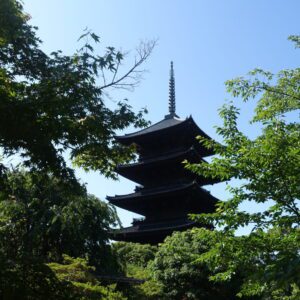
Toji Temple was founded in 796. It was built as an national temple for the protection of the Heian-kyo capital. Later, in 823, Emperor Saga bestowed Toji Temple to Kukai (Kobo Daishi), who made it the Konpon Dojo (fundamental training hall) of Shingon esoteric Buddhism. Toji Temple is the only remaining structure from the Heian-kyo period. Due to several fires, no buildings from the time of its foundation remain in Toji Temple. However, the orderly arrangement of the temple buildings in a straight line from south to north and the scale of each building remain as they were in the Heian period.
Kondo, a national treasure, was rebuilt in 1603 with contributions from Hideyori Toyotomi. The architectural style is a combination of the Wo-yo style and the Daibutsu-yo (Tenjuku-yo) style. The main statue, a Yakushi Nyorai, is 288 cm tall. It is very attractive with a calm expression. I felt as if I wanted to gaze at the Yakushi Nyorai statue forever. The statue of Yakushi Nyorai is a national important cultural property.

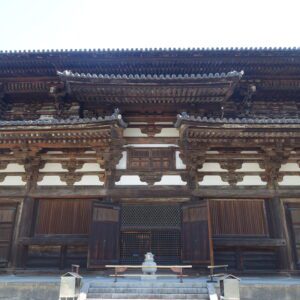
The Kodo (auditorium), a national important cultural property, was rebuilt in 1491. Inside the Kodo is a three-dimensional mandala consisting of a total of 21 Buddhist statues, 16 of which are national treasures and 5 are national important cultural properties. Inside the main hall, there are only three statues of Yakushi Nyorai and his two side chaplains, which I could appreciate very calmly, but the 21 statues inside the Kodo are too many for me to appreciate calmly. I prefer the inside of Kondo.

The five-story pagoda, a national treasure, was destroyed by fire four times due to lightning and suspected case of arson. It was rebuilt by Iemitsu Tokugawa in 1644. The five-story pagoda is 54.8 meters high, making it the tallest wooden pagoda in Japan. It is a very beautiful five-story pagoda with black as its base color. The bottom roof of the five-story pagoda is supported by an evil demon (Amanojaku). It is supported at the four corners.

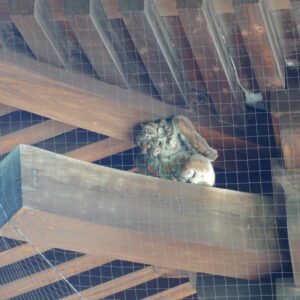
The East Gate is called “Akazu-no-mon” (meaning “the gate of non-opening”) due to the legend that Takauji Ashikaga, who was attacked by Yoshisada Nitta in 1336, escaped from the disaster by closing this gate. It is a national important cultural property.
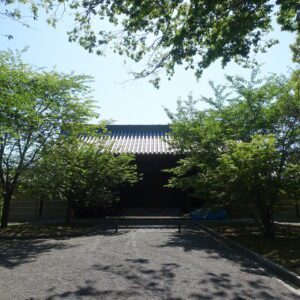
Keigamon, the entrance to Toji Temple, is also a national important cultural property.
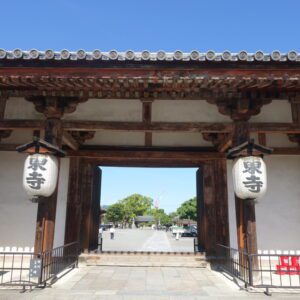
I left Toji before 9:00 a.m. this time, so I could not visit Kanchiin (national treasure), which opens at 9:00 a.m. I would like to visit Kanchiin next time.
2. Fushimi Inari Taisha
After a very satisfying morning tour of Toji Temple, I rented a bicycle and went to Fushimi Inari Taisha. The cost of renting a bicycle was Yen 1,300 per day for a bicycle with a gearshift. However, the cost for a bicycle with electric power assist would be Yen 2,300 per day. Kyoto is a famous tourist destination, so it is more expensive than other tourist destinations. However, the most expensive rental bicycle I used in the past year was in Biei-cho, Hokkaido. An electrically assisted bicycle cost Yen 3,000 per day.
Fushimi Inari Taisha is a very popular tourist destination for both domestic and international visitors due to the presence of the Senbon-torii (thousand torii gates). This was my first visit. It took me about 15 minutes by bicycle from Toji Temple to Fushimi Inari Taisha. The nearest station to Fushimi Inari Taisha is Inari Station of JR West Japan. It is only a one-minute walk from Inari Station to the Otorii gate of Fushimi Inari Taisha.
Even though it was after 9:00 a.m. on a weekday morning, Fushimi Inari Taisha was very crowded, mainly with students on school excursions. This made me worry about what would happen if foreign tourists returned.
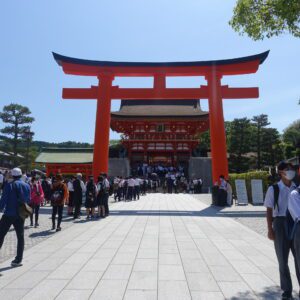
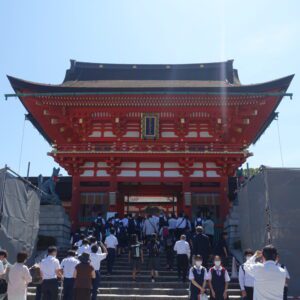
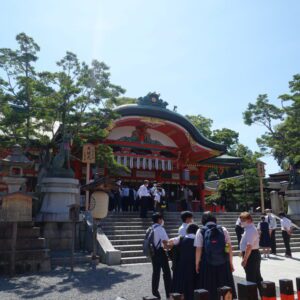
Fushimi Inari Taisha is the head shrine of the approximately 30,000 Inari shrines in Japan. Fushimi Inari Taisha was founded in the Wado period (708 – 715), and is mentioned in the Pillow Book and Konjaku Monogatari-shu. The shrine became a Shinto shrine on Buddhist temple grounds dedicated to the tutelary deity of the area during the construction of Toji Temple, and its beliefs expanded as it became associated with Shingon esoteric Buddhism. Even today, on the last day of the Inari Festival, Toji priests lay out offerings in front of the Keigamon and recite sutras, continuing the deep relationship between Fushimi Inari Taisha and Toji Temple.
The tower gate, main shrine, and outer shrine of Fushimi Inari Taisha are national important cultural properties.
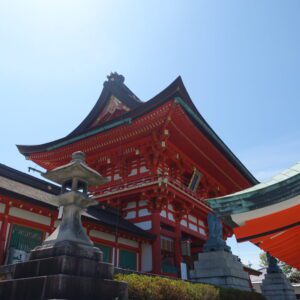

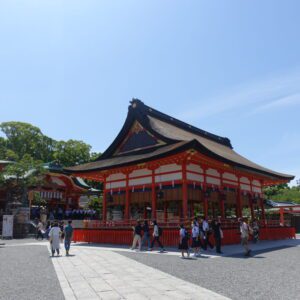
As mentioned earlier, the area was overflowing with many tourists, but I miraculously encountered a timing when there were no tourists at all at the Senbon-Torii. Therefore, I was able to take pictures that did not show any people at all.
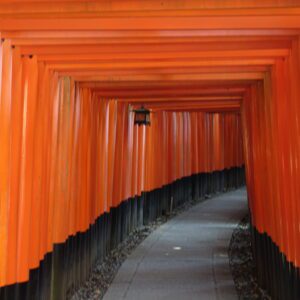
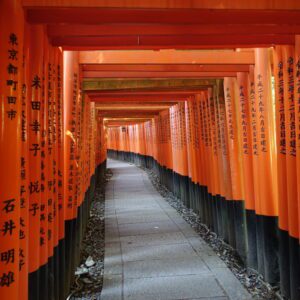
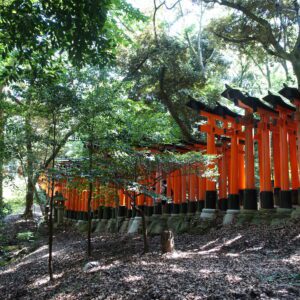
3. Hotoji Temple
Fed up with too many tourists at Fushimi Inari Taisha, I went to Hoto-ji Temple, less than five minutes away by bicycle. There were no tourists at Hotoji Temple.
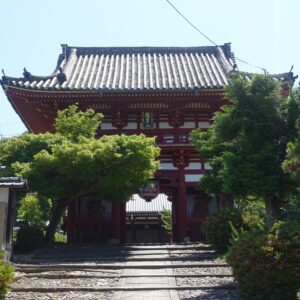
Hotoji Temple is said to be the predecessor of Gokuraku-ji Temple, a Shingon sect temple founded by Mototsune Fujiwara (the first Kanpaku, the chief adviser to the Emperor in Japanese history) in the Kasho era (848 – 851). It is also one of the settings of the Tale of Genji.
The main hall was rebuilt in 1608. It is the oldest main hall of a Nichiren Shu temple in Kyoto. It is designated as a national important cultural property.


The two-storied pagoda was built before 1439 in the Muromachi period (1336-1573). It is the oldest two-storied pagoda in Kyoto. At 11.4 meters in height, it is a small two-storied pagoda, but it is a very neat and well-balanced pagoda. The two-storied pagoda is also a national important cultural property.
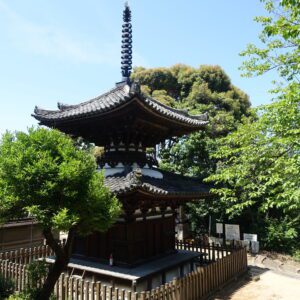
The main gate, built in the Muromachi Period (1336-1573), is also a national important cultural property.
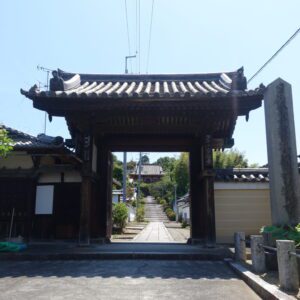
4. Tofukuji Temple
After Hotoji Temple, I went to Tofukuji Temple. It took less than 10 minutes by bicycle.
Tofukuji Temple was founded in 1236. The name of the temple was taken from the characters for “To” and “Fuku” in the two major temples in Nara Prefecture, Todaiji Temple and Kofukuji Temple, and the temple was named Tofukuji Temple. The regent Michiie Kujo (father of the fourth shogun of the Kamakura Shogunate, Yoritsune Fujiwara) built the largest temple complex in Kyoto and constructed Tofukuji Temple. Tofukuji Temple was selected as the fourth temple rank in the “Kyoto Gozan (Five Temples of Kyoto)” (temple ranks of the Rinzai sect) established by Yoshimitsu Ashikaga, the third shogun of the Muromachi Shogunate. The “Kyoto Gozan” temples are Nanzenji Temple (ranked separately), Tenryuji Temple (ranked first), Shokokuji Temple (ranked second), Kenninji Temple (ranked third), and Manjuji Temple (ranked fifth).
The Sanmon Gate was rebuilt in 1425 by Yoshimochi Ashikaga, the fourth shogun of the Muromachi Shogunate, and is a national treasure. It is the oldest and largest existing gate of a Zen temple in Japan. It is approximately 22 meters high.


The main hall was rebuilt in 1934. It is one of the largest wooden buildings of the Showa period. The Hojo, surrounded by the Honbo garden “Hasso no Niwa,” was rebuilt in 1890.

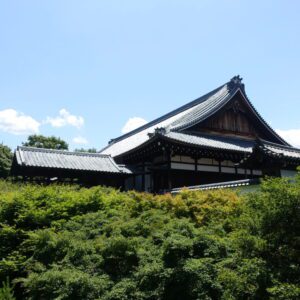
Tosu is the remains of the largest and oldest Zen-style latrine in Japan. It is designated as a national important cultural property. The scripture house was rebuilt in 1794.
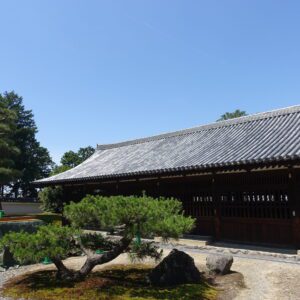
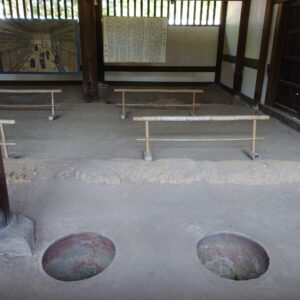
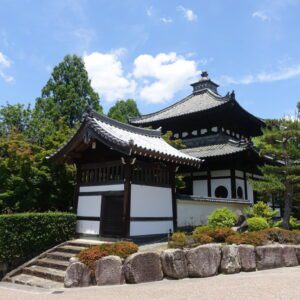
The Honbo Garden “Hasso no Niwa” is a national scenic beauty. The garden was created by landscape architect Mirei Shigemori in 1939. The dry landscape garden is so beautiful that one could gaze at it forever.



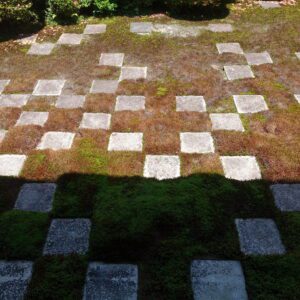
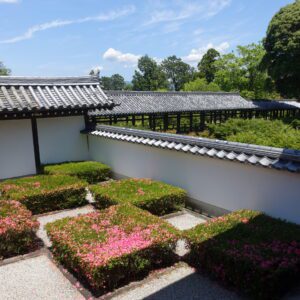
Admission fee: Adults Yen 500, Children Yen 300
Common admission ticket (Honbo Garden, Tsutenkyo Bridge, Kaisando): Adults Yen 1,000 , Children Yen 500
Tsutenkyo Bridge connects the main hall and the Kaisando. During the fall foliage season, it is one of the best views in Kyoto.
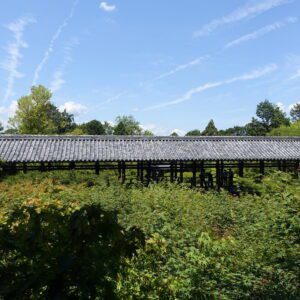
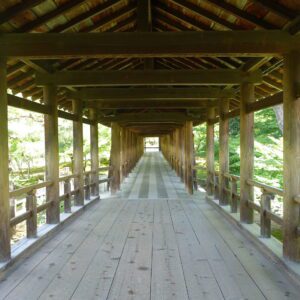
The Kaisando enshrines a statue of the founder of the temple, Enni Ben-En (Shoichi Kokushi). It is designated as a national important cultural property. The garden in front of the Kaisando was very beautiful.
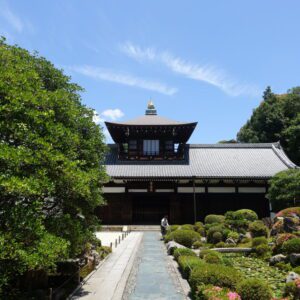

Aizendo, located near Tsutenkyo Bridge and Kaisando, was moved in 1937 from Manjyu-ji Temple, one of the “Kyoto Gozan” temples. It is an octagonal circular hall with a vermillion lacquering wall and shingled roof. The red Aizendo stands out from the muted colors of the Zen Buddhism buildings at Tofukuji Temple. It is a national important cultural property.
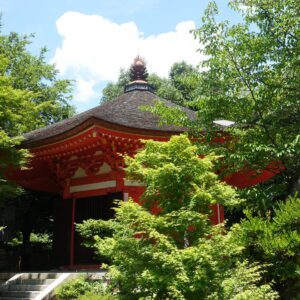
Admission fee: Adults Yen 600 yen, Children Yen 300
Common admission ticket (Honbo Garden, Tsutenkyo Bridge, Kaisando): Adults Yen 1,000 , Children Yen 500
The zendo was rebuilt in 1347. It is the largest and oldest existing zendo in Japan, and it is hard to believe that it was built nearly 700 years ago, with such a beautiful appearance. It is a national important cultural property.
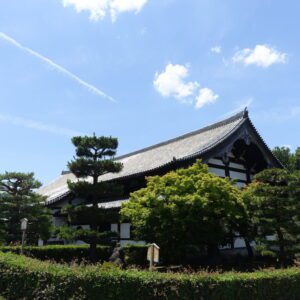
Engetsukyo Bridge is a wooden bridge corridor that was rebuilt in 1603. Unlike the Tsutenkyo Bridge, it is open to traffic free of charge. It is designated as a national important cultural property and is one of the 100 most famous bridges in Japan.
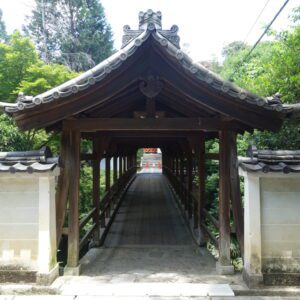
Tofukuji Temple is one of the largest temple complexes in Kyoto, and it took us about two hours to visit them all. It was a very worthwhile Zen temple.
5. Saisho Kongoin Temple / Funda-in (Sesshuji Temple)
Saisho Kongoin Temple is a special historic temple of Tofukuji Temple that was reestablished to manage the tombs of the Kujo family. Hakkakudo is the mausoleum of Kujo Kanemi. Kanezane Kujo held the offices of regent, Kanpaku, and Grand Minister. He was the grandfather of Michiie Kujo, who built Tofukuji Temple, and the founder of the Kujo family.

Funda-in is a Tacchu of Tofukuji Temple. A Tacchu is a small Zen temple built to commemorate the death of a high priest. Funda-in was founded by Tsunemichi Ichijo in the Genko era (1321-1324) for his father Uchitsune Ichijo, with Jozan Sozen as the founder of the temple. It is the family temple of the Ichijo family of the Sekkan family (Konoe, Ichijo, Kujo, Takatsukasa, and Nijo families).
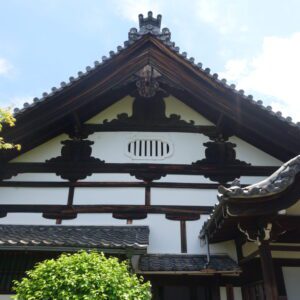
The south and east gardens of Funda-in are dry landscape gardens said to have been created by Sesshu, a famous ink painting artist. For this reason, Funda-in is also called Sesshuji Temple.
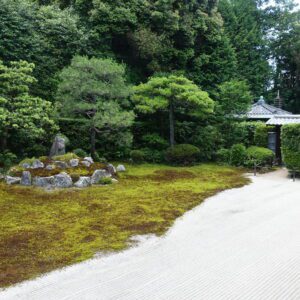
Funda-in admission fee: Yen 300 for high school students and above, Yen 200 for junior high school students and children
6. Unryu-in
I went to Unryu-in next to Fundain. It took about 10 minutes by bicycle. Unryu-in is a branch temple of Sennyuji Temple, which will be described later. It was founded in 1372 by the Emperor Go-Kogon of the Northern Dynasty in the Nanbokucho Period (1368-1368), with Chikugan Shoko as its founder.
Ryukaden (the main hall) has been a place for sutra copying since Emperor Go-enyu believed in the merits of sutra copying. When I visited, there was a person performing sutra copying. Ryukaden was rebuilt in the Kanei era (1624-1644). It is designated as a national important cultural property. The lantern in the photo with Ryukaden was donated by Yoshinobu Tokugawa, the last shogun of the Edo Shogunate.
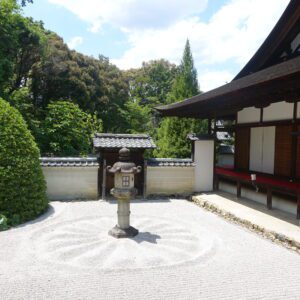
Reimei-den, rebuilt in 1868, is a hall of honor for the royal family.

The Lotus Room has four colored paper-sized windows that offer a beautiful view of the garden, called “Shikishi-no-keshiki.
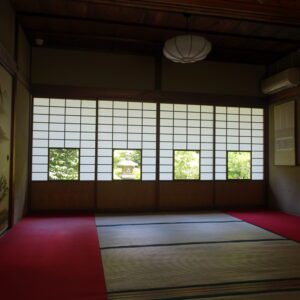
The window in the Shoin Gonoma is called the “Window of Enlightenment” and offers different views depending on the season.

In the Dairin Room, there is a calligraphy of “Ryuen” by Kuranosuke Oishi, who was the first retainer (leader) of the Ako Roshi. It is said that Kuranosuke Oishi, who lived quietly in Yamashina, held a secret rites with the former Ako Ronin at Raigo-in Temple, the Tacchu of Sennyuji Temple.

In addition to the “Shikishi-no-keshiki” and “Window of Enlightenment,” Unryu-in is a fun temple to visit, with many other fascinating features. The “Running Daikokuten (Mahakala)” statue, of which photography is prohibited, is a must-see. It will change your impression of Daikokuten (Mahakala).
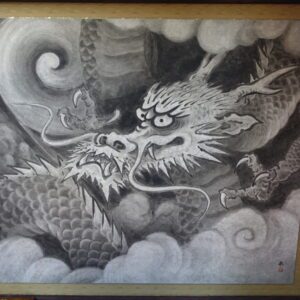
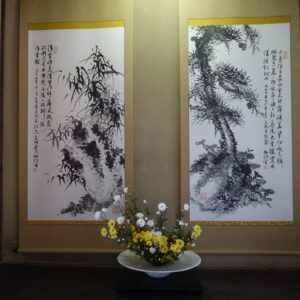
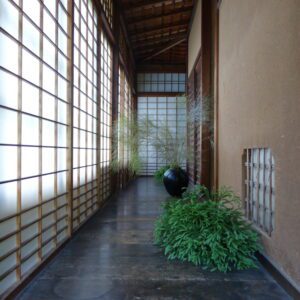

Admission fee: Yen 400
7. Sennyuji Temple
Sennyuji Temple is located near Unryu-in. It is the head temple of the Sennyuji School of Shingon Buddhism. The name Sennyuji comes from the fact that fresh water gushes out from a corner of the temple grounds. The temple is also called “Mitera,” meaning “temple of the emperor,” because of its close connection with the imperial family, as it has hosted many funerals of emperors. The domain name of Sennyuji Temple is also mitera.org. It is said to have been founded in 856, but there are various theories.
The main gate of Sennyuji Temple, the Daimon, was relocated from the south gate of the Kyoto Imperial Palace during the Kanei period (1624-1645). It is designated as a national important cultural property. Most Shinto shrines and Buddhist temples have a slope or stairs leading up from the main gate to the main hall or Buddha hall, but Sennyuji Temple is unusual in that it is located down a slope.
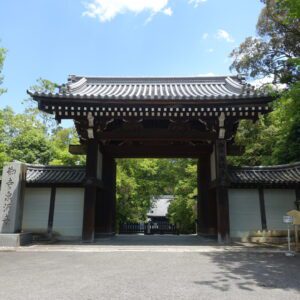
The Buddhist temple was rebuilt in 1668 with the assistance of the fourth shogun of the Edo Shogunate, Ietsuna Tokugawa. It is designated as a national important cultural property.
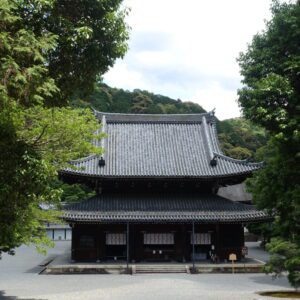
The Shariden, which stands behind the Buddhist temple, is a relocated and remodeled building from the Kyoto Imperial Palace during the Keicho era (1596-1615).
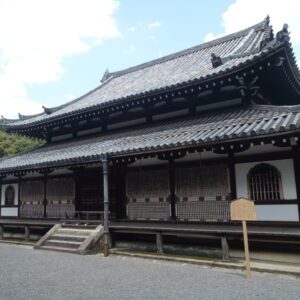
Reimmei-den enshrines the tablets of successive Emperors and Empresses from Emperor Tenji and Emperor Konin to Emperor Showa. The present Reimei-den was rebuilt in 1884 by order of Emperor Meiji.

Sennyusui Yakata was rebuilt in 1668. It is designated as a Tangible Cultural Property of Kyoto Prefecture. It is a yakata that covers the fountain from which Sennyuji Temple derives its name.
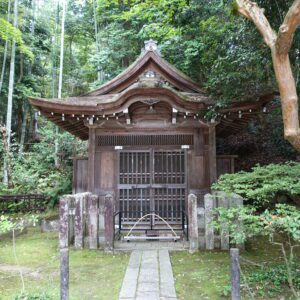
Admission fee: Adults Yen 500, Children Yen 300
Note: Transportation departure and arrival times, fares, entrance fees, and meal prices listed in the text are current at the time of BLOG writing. They are subject to change in the future, so please check them yourself when you travel.